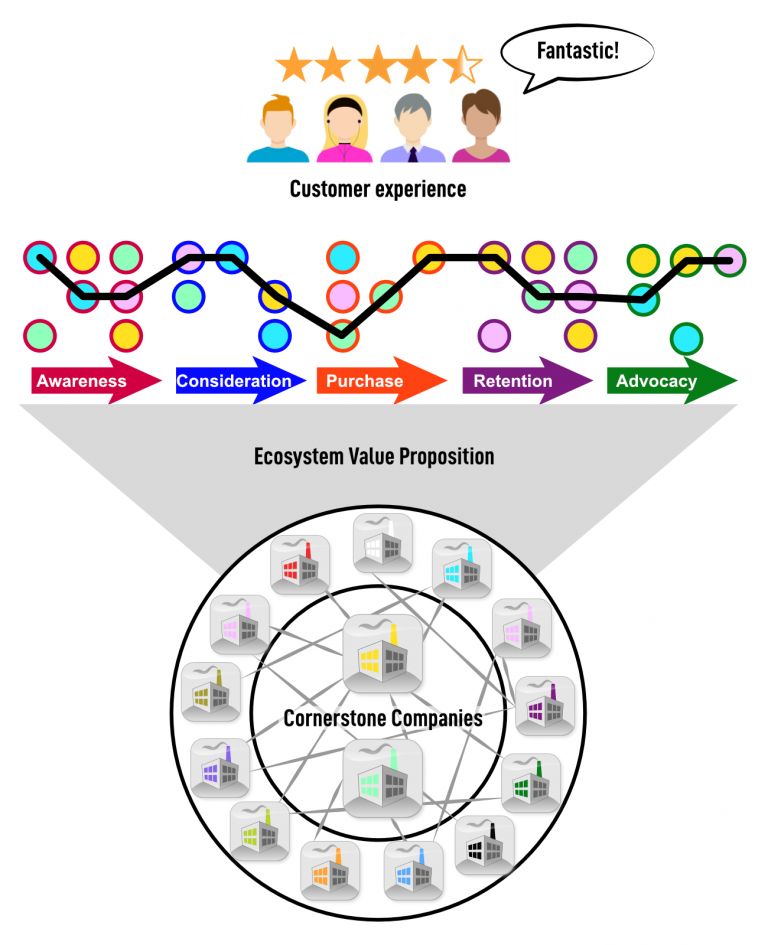If you want to become more future-proof and sustainable, it is crucial you consider a business ecosystem perspective. Ecosystems are the starting point when envisioning a better future for your organisation.
Cornerstones and circles
Business ecosystems are defined as a network of collaborating organisations with some natural form of pollination that takes place expanding the value of the whole. Consider it a community consisting of interdependent organisations generating co-evolution and value.

In the network of collaborating organisations we can identify two circles. The inner-circle consists of the organisations forming the cornerstone of the ecosystem, they collectively create value propositions that are greater than each can create individually. These value propositions are the core, the engine, of the ecosystem. The outer circle is formed by organisations with a strong focus on the overall customer experience optimising the customer journey(s). Typically organisations in the inner circle operate only in one or two ecosystems, organisations in the outer circle bring their value to multiple ecosystems.
Ecosystem comes first
Ecosystems offer great value for customers since they continuously focus on offering better products and services while improving the overall customer experience and optimising the customer journey(s). Looking inside the system, the ecosystem dynamics encourage each company to become the best version of itself, constantly improving efficiency, transparency, standardisation, and reduction of complexity. In addition, the organisations in a business ecosystem continuously evolve roles and capabilities, as well as synchronise investments.
Reframe the definition of growth and success
To make it run like clockwork you have to put the ecosystem objectives before your own objectives, meaning that you truly believe that ecosystem prosperity is essential for your organisation’s growth and success. Reframing the definition of growth and success is not something a management team should treat lightly. Since the start of this decade we see more and more business leaders embrace business ecosystem thinking, primarily to address the rapidly increasing customer expectations and the pace of change and innovation.
Two kind of activities
Ecosystems are easy to understand if you distinguish between two kind of activities. Non-customer focussed activities and customer focussed activities. Examples of non-customer-focused activities can be found in, for example, logistics, operations, IT services, procurement or technology development. Customer-focused activities are activities that require interaction between company and customer.
To compete or not
Despite the common ecosystem objectives some competition will occur battling for the clients attention, at the same time companies are challenged to excel in their contribution to the ecosystems value proposition meaning focus and dedication. In a mature ecosystem, there’s no competition in regard to non-customer-focused activities. All participating organisations can decide to keep utilising their own back-office activities, a smarter option may be to use the activities from their ecosystem partners. In a world increasingly consisting of datasets, microservices and API it is an easier decision to make than it traditionally was.
Three main boardroom questions
For every organisation we believe that business ecosystem thinking is crucial to define how to achieve your ambition. To do so we highlight three main questions that should be thoroughly discussed in the boardroom:
- What ecosystem, or ecosystems, do we consider ourselves part of? If it is puzzling to define your ecosystem, zoom out and take a bird’s eye view. Look at the relevant customer journeys, the value proposition, the competition, related markets, the start-ups and scale-ups attacking the niches, the possible involvement of big tech, your partners, your suppliers and employees. It will help you map and scope your ecosystem.
- How would we define and position our role in this/these ecosystem(s)? Are you part of the cornerstone of an ecosystem or does your company operate in the outer circle of multiple ecosystems? What are your crown jewels in regard to customer-facing activities? Can they exist on their own or are they glued to your non-customer-focused activities? What are your differentiating non-customer-focused activities? Can you offer these activities ‘as-a-service’ to others?
- What is the best long-term strategy for our organisation? What is our company’s business model today and how will it evolve in the next 5 years? What is the ecosystem’s business model today and how will that evolve in the next 5 years?
These questions will produce some interesting output and most likely new questions. The fact is that complex and uncertain questions like these are often intuitively answered. And that’s not the best approach for possibly the most important strategic decision each company has to face between now and 2030 depending on the industry you are in.




